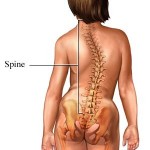Scoliosis is a musculoskeletal disorder in which there is a sideways curvature of the spine or backbone according to the National Institute of Arthritis and Musculoskeletal and Skin Disease (NIAMS).
The musculoskeletal system involves the muscles, bones, joints, bursa (fluid sac between the muscles and bones that form in areas of friction), ligaments (fibrous bands of tissue connecting bone) and tendons (fibrous bands of tissue connecting muscle with bone).
The most common type of scoliosis is the idiopathic that occurs in 80 to 85 percent of people starting during puberty. Girls are more likely than boys to have this type scoliosis. It can be hereditary, if parents or immediate member of the family have it , chances that children will also inherit it.
NIAMS has further classified the causes of curves in scoliosis as structural and non structural. In a non structural scoliosis, a structurally normal spine appears curve. It is a temporary changing curve. It is caused by the following underlying conditions: Difference in legs length, muscle spasms, or inflammatory condition such as appendicitis.
Structural scoliosis can be caused by neuromuscular diseases, cerebral palsy, poliomyelitis, or muscular dystrophy, birth defects due to an underdeveloped one side of the vertebra, injury, certain infections, tumors, metabolic diseases, connective tissue disorders, rheumatic diseases and some unknown factors.
In every 1,000 children, 3 to 5 develop spinal curves that are considered large enough to need treatment. Doctors usually measures the curve from an x-ray image of the patient. Curves that are greater than 20 percent require treatment.
When treatment is needed, the doctor may send the patient to an orthopedic spine specialist who will then take care and treat the problem. The specialist may recommend more observation, support it with bracing or corrective surgery.
Other ways to treat scoliosis include manipulation by chiropractor, electrical stimulation, dietary supplements and corrective exercises. Although so far, these treatment have not shown to prevent curve progression or worsening, but it can minimize any potential decrease in functional ability over time.
Researchers are further investigating idiopathic scoliosis which may shed light as to the cause of this disorder. They will also examine a variety of braces, surgical procedures and instruments of how they can be effectively improved in the straightening of spine and prevent further curvature.
Moreover, they are studying the long term effects of scoliosis fusion and untreated scoliosis.

